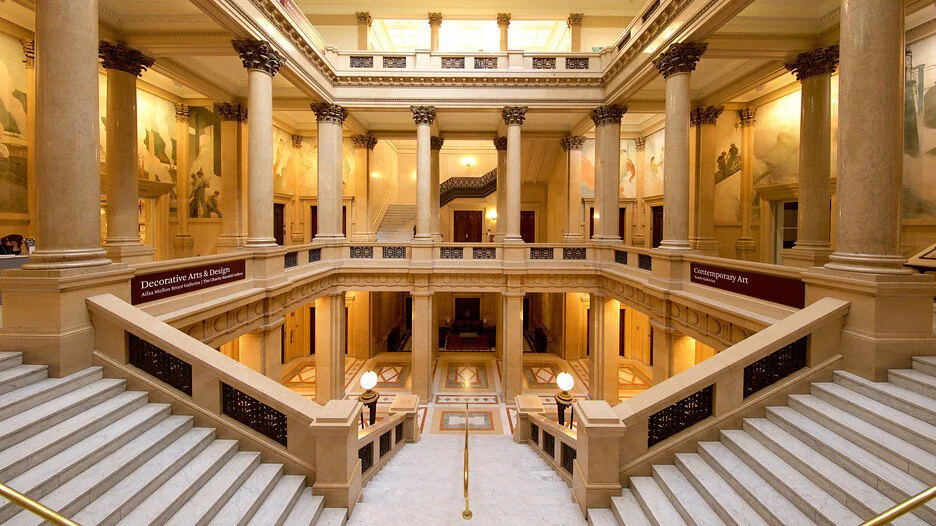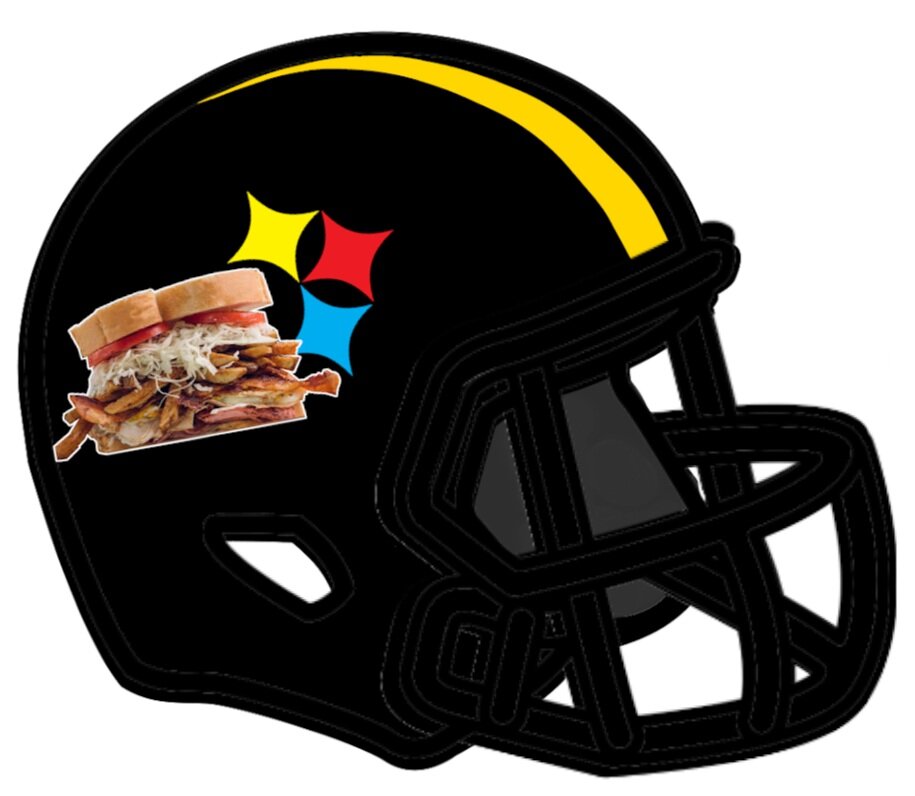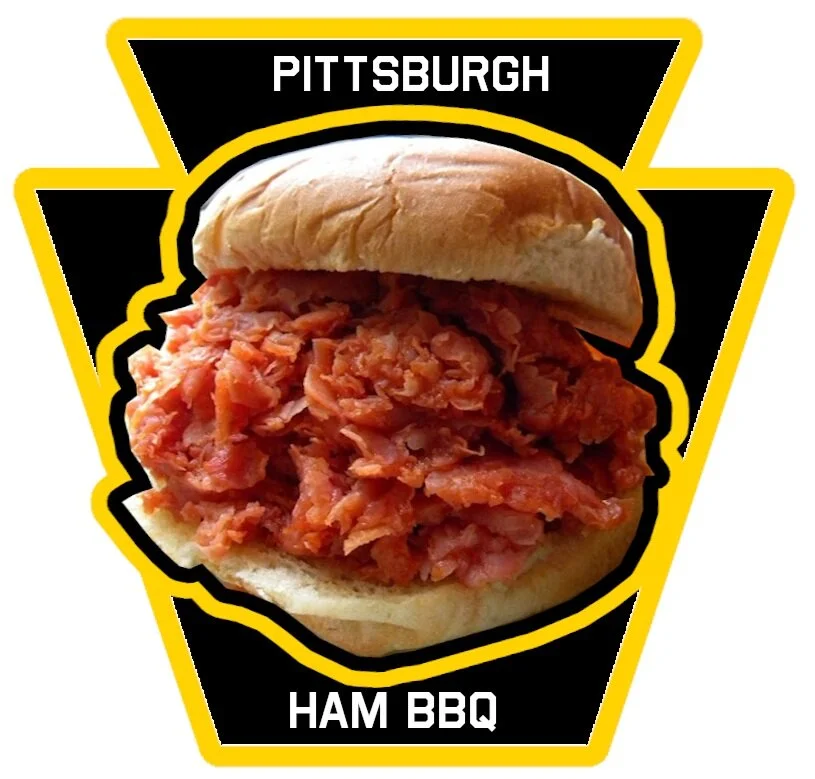"The National Foodball League" Project: Pittsburgh
by Mike “Dahntahn” Lunsford, GGR Editor-In-Chief
When I decide which city is going to be next on this food/history/graphic arts adventure, sometimes there’s a regional sensibility. After Buffalo, I changed that trend and took a little virtual vacation to everyone’s favorite news headline punching bag, Florida. To honor a historic season from the Browns, I traveled back north to discuss the great city of Cleveland. When it came time to choose the next city to discuss, I decided that it was only natural to choose a rival to the previous entry. Now, one could make a case that Cincinnati is Cleveland’s greatest rival but truly, the Queen City is more of a drinking buddy. Cincinnati is a comrade in pain as neither team has had much success in their sports endeavors. That rival is the football town that has all the success, all the luck, all the good fortune, the model of consistency in professional football since the 1970s. We are speaking of the Steel City: Pittsburgh.
Wow. Look at that picture! What a beautiful scene! Pittsburgh has it all, seemingly. We’ll dive into it all, but let’s start with the history.
History
The Shawnee and several other settled groups of native people had lived where the Ohio, Allegheny and Monongahela Rivers converge for centuries when they collided with European settlers. The first known Europeans to enter the region were French explorers/traders in 1669. It didn’t take long for the French to establish camps in the area. In 1749, French soldiers from Quebec launched an expedition to the forks to unite Canada with French Louisiana via the rivers. Not to be outdone by their sworn enemies, the British hastily built Fort Prince George to stake their claim to the area. In response, the French built Fort Duquesne based on their 1669 claims.
The Seven Years’ War began soon after with the area as its center. In 1758, the British took the area and began construction on Fort Pitt, with the settlement was named Pittsborough. I thought it was interesting that the original name of the city was a different pronunciation that what is used today, you don’t see that often with major American cities. Another interesting thought I had, and this was more of a bigger scope concept to any native peoples who saw European invaders: people who had been living in an area for centuries saw two different types of white folk show up, say they wanted the land, fought a war over it while you’re just trying to live your life. Just imagine someone showing up in your neighborhood, planting a flag and saying “I claim this land for my country” just right in front of your face, like you’re not even there. WEIRD, but that happened for centuries in our world.
While reading through the early history of the area, there isn’t much mention of horrible treatment of the native cultures by the French of British. Then you find out that Fort Pitt was the site of one of the first instances of biological warfare as the British officers gave Native American emissaries smallpox-infested items as gifts. Certainly a pattern we’re seeing in the way European settlers treated the original inhabitants of America: there was no such thing as respectful or peaceful.
The city became an important starting point for many settlers. It was the official starting point for the Lewis and Clark Expedition. It was a way station for people moving into the Ohio Valley. As the country started dividing itself into free states and slave-holding states, the Pittsburgh area became a haven for escaped slaves as it was an integral stop on the Underground Railroad. Many former slaves stayed in the area as well.
As the Civil War ramped up, the city’s claim to fame, steel was born. With the need for iron and steel at a high in the country, Pittsburgh became the “Steel City.” Things grew after the war as the city became an industrial hub, becoming a destination for immigrants looking for work. In fact, steel became the backbone of the country’s post-war growth. All those skyscrapers, all the railroads, all the big city growth was built by steel. And without fail, for all the positive things that happened, there were awful working conditions, worker’s rights riots, deaths from negligence and so much more. It must be noted though, that Andrew Carnegie, the man who was integral in helping the steel industry thrive in America, while he was involved in some ugly moments, retired at the age of 46 and devoted his remaining years to philanthropy. He had many progressive beliefs and thoughts on what it meant to be wealthy and what should be done with the excess wealth he possessed. There are countless museums, libraries, performing arts centers and more around the world named after Carnegie’s works. He certainly made many attempts to show that he wasn’t the stereotypical wealth-hording dragon that so many of his contemporaries were.
Carnegie Museum in Pittsburgh
Pittsburgh gained the nickname “the Arsenal of Democracy,” as much of the city’s growth came from developing weapons and armaments. The city’s population boomed again around World War II because of the need for workers in the steel mills. With the majority of the city’s population being immigrants and blue-collar workers, Pittsburgh built it’s reputation as a down-to-earth, hardworking population. The sports teams as well, in particular the football team, has built their identity on that same blue-collar work ethic. The Steelers, one of the most successful franchises in NFL history, are a huge source of pride for the area. And regardless of how you feel about them based on your own rooting interests, they are a model of consistency.
Let’s talk about some delicious stuff, now.
Food
For a lot of people, Pittsburgh’s food scene is viewed to be just like its population: blue collar: comfort food, diner staples, and the like. However in 2019, Pittsburgh was deemed "Food City of the Year" by the San Francisco-based restaurant and hospitality consulting firm af&co. So, the city is not just the cheap stuff! That being said, when analyzing what are the most iconic foods in Pittsburgh, it goes back to those blue-collar, staples that really define the city as iconic.
The area has a large population of Slavic Americans, one of the highest in the country. This is seen in delicacies such as kielbasa and pierogies which are incredibly popular in the area. And I’m sure it burns those Pittsburgh natives that Cleveland got both a kielbasa AND pierogies in their logos, but the bottom line is there are more foods that are uniquely associated with Pittsburgh.
Pittsburgh has how many Super Bowls? Let Cleveland have this one.
Let’s talk about Pittsburgh’s love of putting french fries on everything. I’m sure there are some food critics and snobs who will turn their noses up at the concept, but no one needs elitists ruining a delicious idea. I’m sure you’re thinking “one particular sandwich is NOT ‘putting french fries on everything’ MICHAEL.” So, yes I would agree with that in concept, but the execution of calling me Michael like I’m 9 years old and in trouble is uncalled for.
There’s the famous Primanti Brothers sandwich with fries and coleslaw on it, but did you know that there’s also a Pittsburgh salad with french fries? Yes, it essentially defeats the purpose of a healthy salad, but also…what food hasn’t be improved by adding french fries? And shredded cheese, Ranch dressing, more cheese, sometimes some fried chicken. Look, it started healthy…
maybe the veggies cancel out the fried food? Maybe?
I mentioned Primanti Brothers for a reason. It is easily the most iconic restaurant when it comes to Pittsburgh. People think about the city, they think about the restaurant, and subsequently a sandwich whose identity exudes the blue collar attitude of the Steel City. So what exactly is this sandwich? For those unfamiliar, the Primanti’s style is your standard sandwich condiments: meat, cheese, lettuce, tomato with the added novelty of french fries and coleslaw, all stacked between slices of white Italian bread.
So…why pile all of this into a culinary monstrosity? The original shop was in the Strip District and served the late-night/early-morning workers who were unloading fish, fruits, and vegetables along the Allegheny River. Joe Primanti and his brothers would load up the sandwich then wrap it in a sheet of newspaper and send the busy workers on their way. This way, the worker could go back to their truck and drive back to their shop, eat the sandwich while driving and not getting it all over their lap. There’s an elegance in its simplicity and efficiency.
how do you even eat it?????
What was originally just a working-class meal became a Pittsburgh staple for the bar scene folks as well. The restaurant had open seating that would see college kids and bar-goers mixed with dock workers, truckers and train operators all bonding over cheap beer and delicious sandwiches. Truly, the reason I love writing these articles is how food has the ability to break down walls and bring people together. That being said, my first design for the Pittsburgh “Foodball” team is none other than the sandwich with the city’s name in the title: The Steel City Pittsburgers.
You can pick up some “Steel City Pittsburgers” merch right here! T-shirts, hoodies, long sleeves AND tank tops!
And if I had just haphazardly jumped into the Pittsburgh Foodball article without any major research, I’d be pretty happy with the resulting team name and logos. However, being the person that I am who loves research and finding out about things I knew nothing about, I uncovered a secret, alternate candidate for the logo. Prepare yourself if you’re not from the Pittsburgh area, because you’ve probably never heard of it: chipped chopped ham.
If you’re like me, you probably wondered what this strangely named product even was. By definition, chipped chopped ham or chipped ham if you nasty, is a mixture of ham chunks and trimmings and seasonings, ground together and then packaged into loaves. According to local lore, “by chipping or shaving the meat loaf against a commercial meat slicer blade, the thinly sliced product has a different texture and flavor to spiral cut ham.” Many compare the taste to my #1 seed looks-smells-even-plops-out-of-the-can-like-dog-food processed meat product, Spam. In fact, because Pittsburgh can’t do anything without zhuzhing it up for a sandwich, once the meat is “chipped” it is often fried or heated up and smothered in barbecue sauce…because why not.
If you were expecting a recoil in disgust from me, you picked the wrong blogger, buckaroo.
I’ve yet to have a chipped chopped “ham bbq” sandwich, but with it being compared to Spam I figure that a salted meat that’s been heated up and covered in a sweet and savory sauce is a universal food win, not unlike the Teriyaki glazed Spam hash. Frankly, I was excited to find out about this franken-meat product as it can now join it’s brethren like Spam, Scrapple and the vastly misunderstood Taylor Pork Roll. Here’s Pittsburgh’s alternate Foodball logo.
If you like the Ham BBQ design so much you want to wear it on a shirt, get one here!
Full disclosure, folks: this article took me 2 months to write. It’s not that Pittsburgh was a terribly difficult city to research, or that I didn’t want to write any more. The weight of Covid, pandemic, quarantine and all of the turmoil in our country beat me down. I’m using these last few sentences as a public service announcement. Your own mental health is important. Don’t beat yourself up if you’re not productive. This is a really difficult time for all of us for a million reasons. Expecting constant results from yourself is unrealistic. We are not machines. A friend shared this and i thought it was beautiful.
You are not a machine. You are more like a garden. You need different things on different days; a little sun today, a little less water tomorrow, you have fallow and fruitful seasons. It is not a design flaw, it is wiser than perpetual sameness. What does your garden need today? If you expect a garden to “produce” things with the same regularity and sameness as a machine, you will be disappointed. If you try to maintain a garden the same way you would a machine, you will destroy it. The same is true of your body and emotional life. Give into your garden.
I’ll be back with more cities, more food and more stories soon. Until then, be safe y’all.














